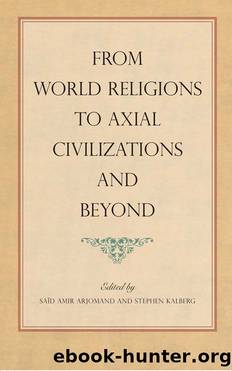From World Religions to Axial Civilizations and Beyond by Saïd Amir Arjomand Stephen Kalberg

Author:Saïd Amir Arjomand, Stephen Kalberg [Saïd Amir Arjomand, Stephen Kalberg]
Language: eng
Format: epub
ISBN: 9781438483405
Barnesnoble:
Publisher: State University of New York Press
Published: 2021-07-02T00:00:00+00:00
Concluding Remarks on the History and Theory of Intercivilizational Encounters
The foregoing discussion has traced aspects of the history of a complex of ideas born especially in Greece, adapted to related images in ancient Judaism, and further developed for their own purposes by early Christian thinkers. It has also shown some of the uses to which the classical Roman jurists put this image, adopting it directly from Greek sources through a separate intercivilizational encounter, without reference to Jewish and Christian thinkers. Finally, it has gestured more briefly to the rich and varied subsequent uses of this image in Western European intracivilizational history. In all these cases, variations on the category of quantity or number were put to use in the creation of images used as rationales for differing philosophical, political, theological, and juridical purposes. At the same time, the adoption of images derived from the category of quantity or number advanced the fuller theoretical rationalization of these same cultural spheres.
In particular, we have argued that the central image of a world created, judged, and ruled by measure, number, and weight and the ways it was employed by intellectual elitesâphilosophers, theologians, juristsâin differing contexts, emerged from a series of intercivilizational encounters. It was unlikely to have developed independently in any other way or merely within the context of any one cultural setting. While our key image owes a special debt to ancient Greek thinkers, as we have seen, it is not exclusively from the âspiritâ of any single civilization that new intellectual innovations associated with it were born, but rather from the confluences of ideas flowing from varying sources across national boundaries into a wider stream in which civilizational actors were immersed. Actors caught up in the maelstrom of such encounters forge new ideas and images, often in defense of their own cultural traditions, often to elaborate new structures of consciousness from their own basic stock of ideas, and sometimes merely to add important formulae to better capture existing ways of thinking.
In all these cases, there is the transfer of the sort of spiritual values that Marcel Mauss (2000) discovered at the heart of gift exchange. By contrast, civilizations that harden their inherited traditions against such âalienâ ideas in the name of retaining the âpurityâ of their civilization are likely to miss opportunities for further transformation in the long term of historical development. These civilizations will find themselves isolated from other civilizations, which repeatedly borrow and adaptâand, in this way, change and grow. Our case study leads to this conclusion.
Download
This site does not store any files on its server. We only index and link to content provided by other sites. Please contact the content providers to delete copyright contents if any and email us, we'll remove relevant links or contents immediately.
Getting It, Then Getting Along by L. Reynolds Andiric(463)
Global Justice, Christology and Christian Ethics by Lisa Sowle Cahill(291)
Positive Psychology in Christian Perspective: Foundations, Concepts, and Applications by Charles Hackney(237)
Christian Martyrdom and Christian Violence by Matthew D. Lundberg;(141)
God and Eros by Patterson Colin;Sweeney Conor;(125)
The Oxford Handbook of Greek and Roman Mythography by R. Scott Smith;Stephen M. Trzaskoma;(124)
Autobiography, Volume 2: 1937-1960, Exile's Odyssey by Mircea Eliade(116)
Cult Trip by Anke Richter(110)
An Introduction to Kierkegaard by Peter Vardy(100)
Witches: the history of a persecution by Nigel Cawthorne(99)
The Myth of Disenchantment by Jason A. Josephson-Storm(95)
The First Thousand Years by Robert Louis Wilken(95)
The Global Repositioning of Japanese Religions by Ugo Dessi(92)
Finding Washington: Why America Needs to Rediscover the Virtues of Her Most Essential Founding Father by Richard Raines(87)
From World Religions to Axial Civilizations and Beyond by Saïd Amir Arjomand Stephen Kalberg(86)
Family in the Bible by Richard S. Hess(85)
The A to Z of Hinduism by Bruce M. Sullivan(84)
Insurgency, Counter-insurgency and Policing in Centre-West Mexico, 1926-1929 by Mark Lawrence(84)
Devadasis of India by Veenus Jain(84)
